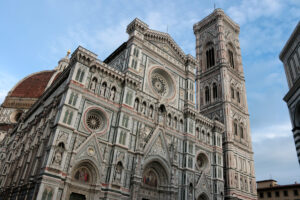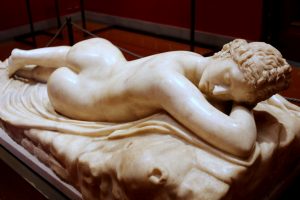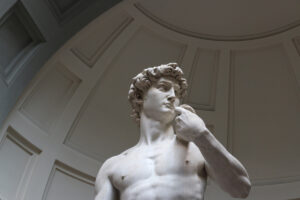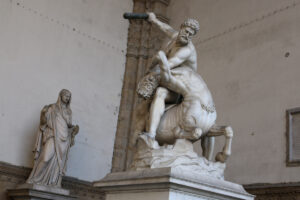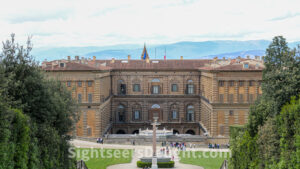Basilica di Santa Croce or Basilica of the Holy Cross is the principal Franciscan church in Florence and the largest Franciscan church in the world. Construction on the church began on May 12, 1294, and the building’s original location was outside the city walls. Legend says St. Francis founded Santa Croce. Some of Italy’s most illustrious Italians, including Michelangelo, Galileo and Machiavelli, are buried in the Santa Croce.
The crown jewel of Florence is the Duomo Santa Maria del Fiore. The glorious cathedral dwarfs most other buildings in this city of about 356,000. Construction started in 1296 and was completed in 1436. Filippo Brunelleschi designed the famed dome. The building’s façade, generally described as a “neo-gothic façade of white, red and green marble,” is relatively new. It was completed in 1887 when the church was 591 years old.
Chiesa di San Salvatore di Ognissanti or the Church of All Saints dates to the 1250s, but architect Bartolomeo Pettirossi rebuilt the church in Baroque-style around 1627. The Vespucci family attended the church, and Amerigo Vespucci is buried here. The church features 15th frescoes by Domenico Ghirlandaio and Sandro Botticelli, who is also buried in the church. Ghirlandaio created a fresco of the Last Supper in the refectory. The work may have influenced Leonardo da Vinci’s later work in Milan.
Galleria degli Uffizi is arguably the most famous art museum in the world. It makes sense considering Florence is the birthplace of the Renaissance in the 14th century. The museum is located in the Historic Centre of Florence and opened as a museum in 1769. Among its famous works of art is Sandro Botticelli’s 15th century “Birth of Venus.” It also houses works by Michelangelo, Raphael and Leonardo da Vinci.
The Galleria dell’Accademia di Firenze (Gallery of the Academy of Florence) is home to Michelangelo’s famed David statue and is the second most visited art museum in Italy. The museum dates to 1784 and has been home to the David sculpture since 1873. In addition to its most famous work of art, the museum houses paintings by Florentine artists, many from 1300-1600.
Giardino di Boboli or the Boboli Gardens is a vast garden located behind the Pitti Palace. It features a collection of Roman antiquities and sculptures from the 16th through the 18th centuries. The Boboli Gardens were laid out for the wife of Cosimo I de’ Medici, Eleonora di Toledo.
Benci di Cione and Simone di Francesco Talenti built the Loggia dei Lanzi, also known as the Loggia della Signoria, between 1376 and 1382. It is located on a corner of the Piazza della Signoria and adjoins the Uffizi Gallery. More than anything, the building is an open-air museum as it houses many historic statues.
The Museo dell’Opera del Duomo (or the Museum of the Works of the Cathedral in English) is home to many of the original works of art created for Florence’s famed Cattedrale di Santa Maria del Fiore (better known as the Duomo). The museum, which has been called “one of the world’s most important collections of sculpture,” opened in 1891. Its collection includes Lorenzo Ghiberti’s doors for the Baptistery of Florence Cathedral (called the Gates of Paradise) and The Deposition, a pietà Michelangelo sculpted and intended for his tomb.
Dominican friars founded Officina Profumo-Farmaceutica di Santa Maria Novella in 1221, making it one of the oldest pharmacies in the world. It is part-museum, part-store selling traditional perfumes and elixirs. The Farmaceutica has been open to the public since 1612.
The Palazzo Pitti or Pitti Palace dates to 1458 and was the town residence of Luca Pitti, a Florentine banker. The Medici family bought the place, which is on the south side of the River Arno, a short distance from the Ponte Vecchio, in 1549. It served the main home of the ruling families of the Grand Duchy of Tuscany and grew as a great treasure house. Later generations amassed paintings, plates, jewelry and luxurious possessions. Napoleon used the palace in the late 18th century, and King Victor Emmanuel III donated the building and its contents to the Italian people in 1919.

